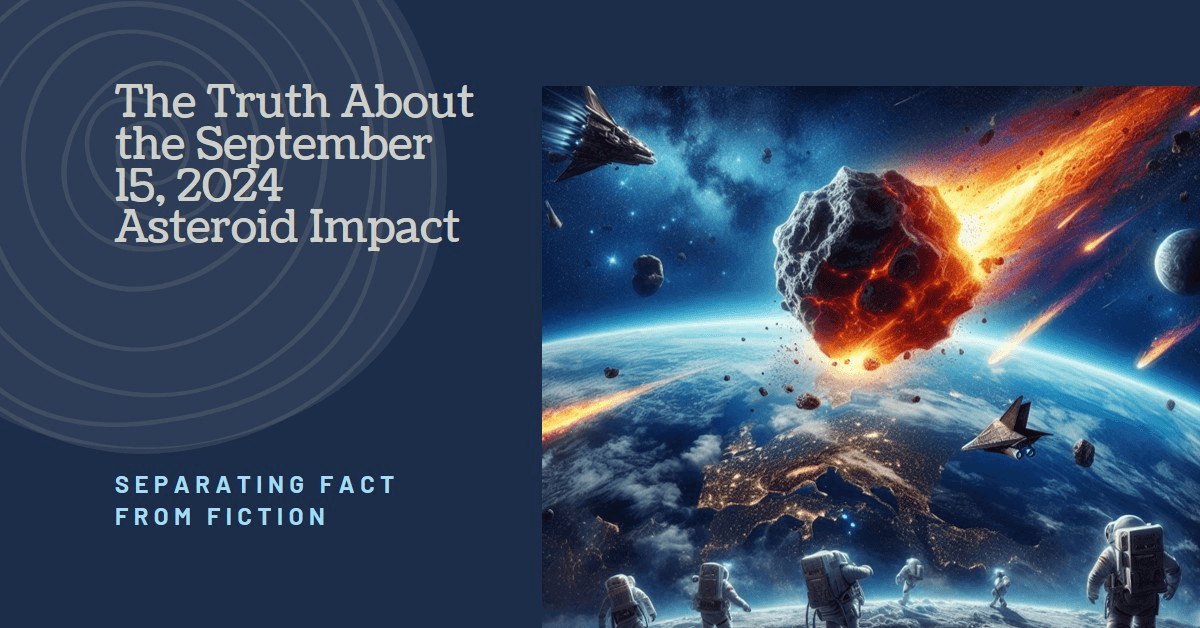On September 15, 2024, concerns about an asteroid potentially colliding with Earth reached a peak. Speculation had circulated for months regarding this celestial object’s trajectory, sparking discussions across scientific communities and social media platforms. Fortunately, despite the heightened fears, no asteroid hit Earth on this date, and the planet remained unscathed. Here’s a closer look at what happened, the science behind asteroid monitoring, and how this event became a significant topic of discussion.
The Origin of the Speculation

The asteroid in question, officially known as 2024 SD-1, was first discovered by astronomers in early 2023. Initially, its path seemed to bring it uncomfortably close to Earth in mid-September 2024. This raised concerns due to the potential impact an asteroid of this size could have. NASA’s Near-Earth Object Observations Program (NEOO) and other space agencies quickly began monitoring the asteroid’s trajectory.
Early predictions suggested a small probability of collision with Earth, causing panic on social media and in some parts of the general public. News outlets and online forums buzzed with doomsday predictions, prompting NASA and other space agencies to provide regular updates about the asteroid’s movement.
The Science Behind Asteroid Monitoring
Asteroid tracking relies on sophisticated technology, including telescopes and radar, to map the paths of objects that come close to Earth. According to NASA’s Planetary Defense Coordination Office, Earth faces frequent encounters with small asteroids and space debris, but most of them burn up in the atmosphere, posing no threat.
Larger asteroids, however, require careful observation due to the potential catastrophic impact they could have if they hit Earth. Agencies like NASA and the European Space Agency (ESA) collaborate to monitor these objects, using software to project their paths years in advance. This ensures that if an asteroid poses a real threat, we would have ample time to react with possible countermeasures, such as deflection strategies.
What Happened on September 15, 2024?
As the date approached, more accurate measurements of the asteroid’s trajectory were obtained. By early September, it was clear that 2024 SD-1 would not hit Earth, passing by at a safe distance of 5 million kilometers—roughly 13 times the distance between Earth and the Moon. While still close on a cosmic scale, this flyby posed no risk to the planet.
On September 15, the asteroid passed Earth as predicted, visible through telescopes but entirely harmless. Scientists used this opportunity to study the asteroid’s composition and speed, adding valuable data to the growing field of planetary defense.
The Role of Media and Misinformation
Despite NASA’s repeated assurances, the possibility of an asteroid impact remained a popular topic of speculation online. Social media platforms like Twitter (now X) and YouTube were flooded with apocalyptic predictions, conspiracy theories, and misinformation. Many posts falsely claimed that governments were hiding the true extent of the danger. This is a common occurrence with events of this nature, as the fear of an unknown catastrophe tends to spread faster than the scientifically verified facts.
To combat this, space agencies and reputable media outlets frequently released updates and clarifications, but the situation highlighted the broader issue of how misinformation spreads on the internet. It also underscored the importance of relying on credible sources for information related to scientific phenomena.
For further insights on how misinformation spreads during such global events, you can read this article on our website.
Future Asteroid Threats: What to Expect
While 2024 SD-1 passed by without incident, it raised important questions about Earth’s preparedness for future asteroid encounters. Currently, there are several ongoing projects aimed at planetary defense. NASA’s DART (Double Asteroid Redirection Test), conducted in 2022, successfully demonstrated the ability to alter an asteroid’s path. Future missions are in the planning stages to expand our defense capabilities against potential asteroid threats.
According to experts, the likelihood of a massive asteroid impact remains low. However, as our technology improves, so does our ability to detect smaller objects, ensuring that even less significant threats are identified well in advance.
For more on NASA’s planetary defense missions, visit the NASA Planetary Defense page.
Conclusion
The asteroid that many feared would collide with Earth on September 15, 2024, thankfully did not pose any danger. As space agencies continue to monitor near-Earth objects, it’s crucial that the public remains informed through credible sources and avoids falling for sensationalist or unfounded claims. Asteroid tracking technology has made significant advancements, giving humanity the tools to prepare for and even prevent future impacts.
To stay updated on space news and planetary defense, make sure to follow our dedicated section on Space & Astronomy.
Internal Links:
External Links:










